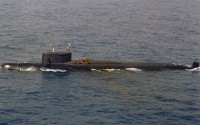The submarine Type VII-class
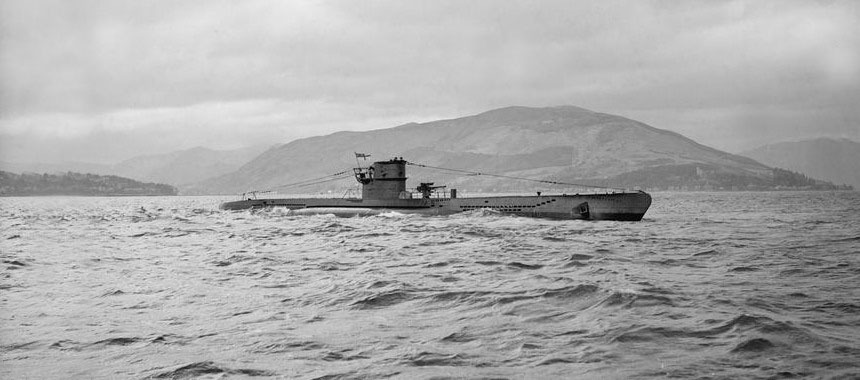
At 21 minutes to eight in the evening of 3 September 1939, the SS Asthenia, outward bound from Liverpool to Montreal with 1400 passengers, was struck by a torpedo. This was the first attack in the Second World War to be made by the German Navy, and the torpedo was fired by U-30 type VII U-boat, commissioned in 1936. On 10 July 1945, the British steam fishing boat Kned was sunk by mine off Lizard Head, in a minefield laid in August 1944 by U218, a VIID U-boat, commissioned in 1942. Thus the German naval war began and ended in submarine action.
Despite the operations carried out by the glamorous surface ships, such as Bismarck, Graf Spee, Scharnhorst and Tirpitz, the major effort of this war was made by the Submarine Arm, which began hostilities continued for five years and nine months, although Britain had instituted convoy sailing as early as August that year.
The early stages of the war resulted in some singular successes for the U-boats: Prien and U 47 entered Scapa Flow and (after a number of attempts) sank the Royal Oar at her moorings; Schuhart in U 29 sank HMS Courageous at sea. But throughout this period, and the much longer one that followed it, the main task of the U-boats was not in single handed derring-do, but the ceaseless grind of sinking merchant vessels, and most particularly merchant vessels in the North Atlantic that were supplying food, stores, weapons and ammunition from the vast manufacturing and supply warehouses of the Americas. If the U-boats could deny Britain the supplies that sailed across the Atlantic, Germany could count on the United Kingdom not only being removed from active participation in the war, but the island itself would be denied to America as a stepping-stone to Europe for the necessary invasion. The stakes were extremely high, and the German Navy soon invested all that it could afford in submarines, for the surface fleet never achieved the strength and balance planned by Raeder.
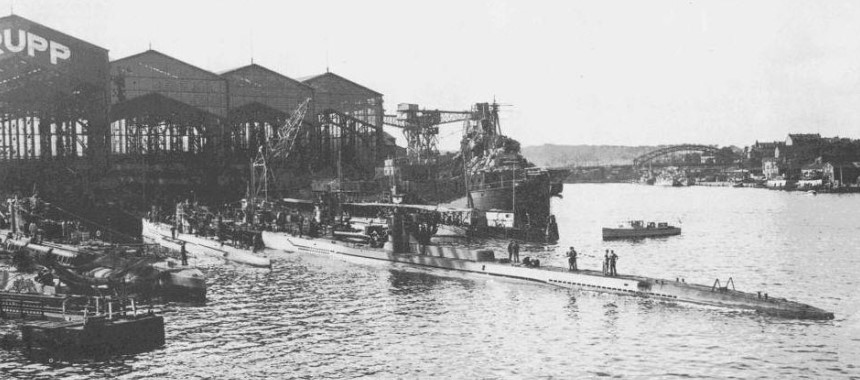 The submarine Type VII class
The submarine Type VII class
Once the French Atlantic ports had been captured, the U-boats increased their range and their rate of operation, for they no longer had to circumnavigate the British Isles (the Channel was denied them by the Dover mine barrage); from the West Coast of France the Type VII boats could now reach out into the western part of the North and Central Atlantic, as well as operating in the Mediterranean and in the vicinity of the Azores and Gibraltar. For many months Donitz suffered from a continual shortage of boats; this was due to Hitler’s almost total lack of understanding of sea power, especially the importance of the North Atlantic, both strategically and economically. When Russia was invaded, the supply of steel and manpower became even shorter, and Donitz waged a running battle with the Army for enough of both to build and crew the boats he needed to increase U-boat strength. He also campaigned — but in this instance lost — for a naval air arm. All he obtained were a few Focke-Wulf Fw 200 «Kondor» aircraft for aerial reconnaissance (many of which were almost continually grounded). Consequently he had no eyes constantly over the Atlantic watching for his tardiest — the convoys.
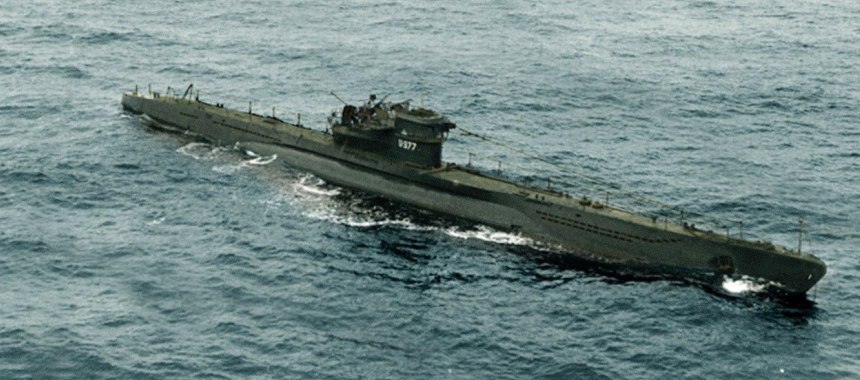 The Type VII U-Boat
The Type VII U-Boat
However he did evolve one tactic which optimized the performance of the Type VII. Underwater it had a low speed, but on the surface they could make 16-17 knots; Donitz reasoned that if the U-boats were to have any chance of attacking the convoys successfully, they could range the shipping lanes freely, looking for their targets, and report positions and courses to his headquarters so that he could order concentrations of boats for devastating attacks at night. This tactic proved extremely successful, the more so when the most experienced commanders — such as Prien, Kretschmer, Schepke, Schultze and others — actually began to go inside the convoys at night, firing their torpedoes from a mere two or three hundred meters. They reaped a terrible harvest.
By 1941 there was distinct increase in the overall strength of the U-boat arm, and this was maintained, despite increasing losses, almost to the end of the war. The overall effectiveness of the arm began to fall however, from mid-1943. Allied countermeasures, initially woefully lacking, improved to such an extent that they eventually denied to the U-boats their one advantage — the ability to operate on the surface at night. By May 1943 the era of the Type VII was almost over: in the three months from March the Allies combination of centimeter radar, seaborne direction-finding equipment, and very long range patrol and attack aircraft, coupled with increasing strengths and co-ordination of convoy escorts and successful anti-submarine tactics, forced Donitz to withdraw the U-boats from the North Atlantic convoy routes, to seek safer targets elsewhere.
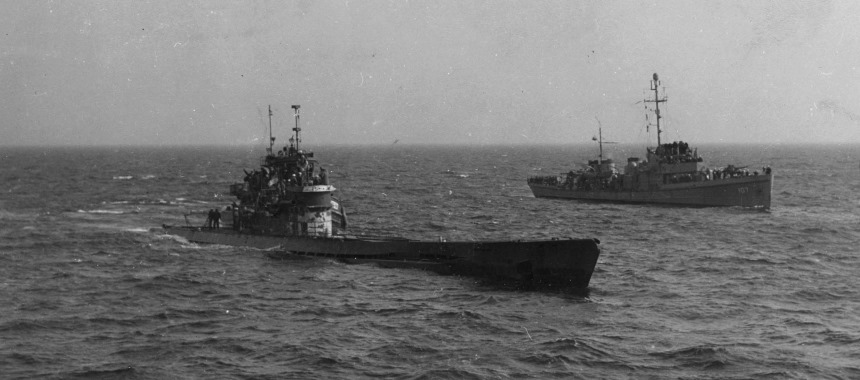 German submarine U-1228 surrenders at Portsmouth NH in May 1945
German submarine U-1228 surrenders at Portsmouth NH in May 1945
They enjoyed little peace in the more remote areas however; for a tactic had proved unsuccessful initially — task forces hunting U-boats, rather than defending convoys — now reappeared with the advent of the escort carrier hunter group. Spearheaded by the US Navy, the hunter-killer groups soon had significant successes. This sudden reversal at the sea forced the German Navy onto the defensive until such time as the new Type XXI boats (with a high underwater speed) were ready to go sea. Happily for the Allies, the northern European land campaign was going so well that those boats never saw service in numbers. Had they done so, the war might have dragged on for a considerably longer time.
The Schnorchel, adapted by the Germans from captured devices fitted to the Royal Dutch Navy`O`type boats, now came into its own, together with a number of increasingly effective (but often too late, and always in short supply) electronic countermeasures. Indeed, it was in the period 1943 to 1945 that the foundations of present-day ECM were laid.
The Type VII may well have become out-dated, but it still found itself involved in all the theatres of naval warfare which it had the range to reach. In all, the Type VII was operating from Bear Island in the Arctic Ocean to the Bermudas and beyond, and from Greenland to Gibraltar, as well as into the Mediterranean. It was the largest class of submarines ever built (704 boats altogether), and certainly sank the lion’s share of the total Allied and neutral shipping losses during the Second World War.
The development of the TYPE VII
The history of German submarine involvement goes back to 1902, when a Spanish submarine designer, d`Equivelley, drew plans for the Forelle, an all-electric boat, which served as the forerunner for many hundreds of subsequent boats. The First World War showed what the submarine could do it economic warfare, and the decision in favor of the Allies was a fine one, dictated far more by events on land and in politics than at sea. One of the decisive factors on land was the injection of large numbers of fresh troops into France from America. Although not winning the battles, they boosted morale and stiffened the not winning the battles, they boosted morale and stiffened the otherwise depleted and almost exhausted defensive lines, and paved the way for decisive advances.
The war over, the submarine threat Germany had posed to Great Britain and France remained high in the consideration of the peace-makers: the Treaty of Versailles banned all manufacture of submarines in Germany, and eliminated her submarine fleet by confiscation. With her surface fleet almost emasculated, and her armaments firms forced back to making metaphorical plough-shares, the Germany Navy had recourse to one expedient only — subterfuge. In the 1920s covert companies were established to research armored fighting vehicles, artillery, aircraft, surface ships and submarines, and many other aspects of the military art. Design types of the late First World War period were scrutinized and new designs and modifications put on paper.
The whole process would have been purely academic had not the strategic possibilities of the submarine, and its value as a coastal defender, been made abundantly clear by operations carried out during World War I. Nations with little need for battleships could see that the submarine could quite easily prove the cheaper countermeasure to the Dreadnought and its succeeding classes.
The countries mentioned, as well as Russia, Italy, Argentina, Estonia, Chile, Rumania, Japan, Yugoslavia, the Netherlands, China, Uruguay, Sweden, Portugal, Norway, Brazil and Bulgaria, all contacted IVS for design studies, and nine boats to these studies were actually build before Germany was allowed once more to possess a submarine arm is her navy. Boats were built for Turkey, Finland, Spain, Sweden, Russia and Rumania. Of these, the Spanish E 1, the Swedish Delfin and the Rumanian Marsuinul all contributed to what was to become the German Type VII class. In 1935 the London Naval Agreement was signed; the actual outcome of the conference was decided on the first day, when the German delegation announced that Germany wanted 35 per cent of the Royal Navy tonnage, and 45 per cent in submarines. If they did not get agreement on these figures, they had, they said, instructions to go home. The British Government and the Admiralty agreed, and further acquiesced in the near demand that Germany could increase her submarine strength to 100 per cent of that of the Royal Navy, should it be deemed desirable by the Germans, and after consultation with the Admiralty in Britain. Needless to say, there was no consultation, but the German submarine strength was almost equal to that of the royal Navy in September 1939.
To return to E 1, the plans were examined in detail by the German Navy, and the design was put on a list of three types which were to be building, clandestinely if necessary, when the Armed Forces were able to re-equip. The arrival of Hitler as Chancellor, and soon Commander-in-Chief of the Armed Forces, meant immediate action in recruitment and rearmament for all three forces, although it was not until March 1935, that the Treaty of Versailles was unilaterally abrogated. Then came the London Naval Agreement, although the U-boats to form the 1st U-boat Flotilla, under the Captain Donitz, were already very close to being launched. Initially the Germans built the very simple, quick-to-complete, Type II boats; these were more for numbers than any thought of strategic value. The first Type VII boat (U 27) was laid down (order number 908 at A G Weser) on 11 November 1935, launched on 24 June 1936, and commissioned on 12 August 1936. This boat was the first of 704 boats of the class.
Building went on very slowly until the war was a year old. In the prewar years Hitler kept assuring Raeder that war would not come until 1944, and so the C-in-C (Navy) planned to build a balanced fleet, with some of the most modern and powerful capital ships afloat; these were to be supported by adequate cruises, destroyers and smaller craft, and a submarine arm of 221 U-boats by 1947. This would have been a formidable force, qualitatively an equal to any European fleet then in being.
War became inevitable far earlier that Hitler and his Grand Admiral believed. The Polish adventure turned into a European war, and the German Navy had very few submarines at all. Added to the paucity of numbers was the initial fear that America would enter the war at the slightest provocation. This led to restrictions being put on U-boat operations (and underscored heavily by the Athenia incident) so that the Type VII boats, and their larger sisters, the Type IXs, were unable at the outset to realize their full potential.
The basic E 1 design was modified four times in 1928. The first design, of February, had six internal compartments, and was 47.95 meters long. The compartments were: bow torpedo compartment; accommodation compartment; control room; diesel engine compartment; electric motor compartment; stern torpedo compartment. In the next three designs this was extended to 7 compartments and 54,25 meters, by the addition of a second accommodation compartment, design for the senior rates, aft of the control room. Ordinary seamen slept forward, among the torpedoes.
The boat was a 755 tons surface displacement, 965 tons submerged. She was fitted with two 1400 hp diesels and two 500 hp electric motors, giving her a maximum surface speed of 17 knots, and a maximum 8,5 knots underwater (this latter speed being of short duration). Carrying nearly 117 tons of fuel oil, she ha a surface range of 11200 nautical miles at 10 knots, and her batteries gave her a submerged range of 180 nautical miles at just 2,5 knots. This slow underwater speed was not considered problematic, because anti-submarine weapons and tactics were still in their infancy, and Asdic was no more at that time than a fond wish of the steering committee.
So it was that the earlier UB type boats of the First World War were merely modified and updated in power, and for this very reason their success was later to be severely limited. But the state of the art in 1930 was far removed from that of 1943. By 1933 a number of boat designs were being considered by the German Navy, some of which were adopted. The Type IA, of which only two were built, was a 500-ton design, which manifested appalling underwater performance characteristics; no more of this class were built. The Type II coastal boats have already been mentioned; it is sufficient to say that their range and torpedo capacity rendered them impractical for strategic warfare. The Type III was a hybrid, designed to carry two motor boats on the after casing in a watertight cylinder, but the design was not developed. The same fate befell Types IV (a supply and generating boat), and Types V and VI (both numbers being reserved for test boats with single propulsion units, capable of surface and submerged running). But the Type VII saw service in seven different forms, and two forms which did not come to fruition.
The designer of the Type VII, based his work on the UB III class o World War I, modified in the light of the experience gained in building by IVS for the foreign customers mentioned above. The form of the boat was that of a cylindrical pressure hull, with bow and stern welded on to the fore and aft sections of the pressure hull. The addition of external casing was to give the boats some sea-keeping capability, which was denied to the simple cylinder of the pressure hull. They were all single-hulled boats, and the drawings show that the pressure hull emerges amidships. A casing deck was added, and the attack centre also ad a casing, in this case designed to improve weather protection on the surface, and enhance underwater performance by reducing water resistance.
Power then was provided by the diesels and the electric motors and searing on the surface by engine manipulation and the rudder aft. Diving, attitude and surfacing was controlled by a combination of the buoyancy of the boat, forward speed, and the angle of the two sets of hydroplanes.
External weapons comprised, at first, a main deck gun (88 mm) and a single anti-aircraft cannon, usually of 2 cm caliber. This, as will be seen from the Drawings, was altered considerably after the events of the spring of 1943, until a few U-boats were equipped as aircraft traps, an experiment which soon proved of no significant. But the main armament of the submarine is the torpedo, and the torpedoes used were mainly Type G7a and G7e, with issue later in the war of Zaunkonig, LUT and FAT type weapons.
The boats were designed with as much of their length forward of the engine room to increase their sea-keeping qualities, and this led to a short stern, in turn cutting the diving time considerably. The original tests of performance indicated that once saddle-tanks were fitted (to increase the boats`capasity to carry fuel oil, and with complementary ballast and diving tanks) performance was worse at surface speeds of 11-13 knots, but improved between 14 and 18 knots. As the range of the boats was increased significantly by the addition of the saddle-tanks, they were retained. What was equally important was the fact that even with saddle-tanks, the boats could submerge in just 30 seconds, more than adequate until the end of the war.
It has already been mentioned that of the Type VII class, the large majority were of VIIC variant; in fact there were 572 VIIC boats built, and 88 VIIC/41 was identical to the VIIC except that the steel used was a higher grade, and capable of withstanding greater water pressure: this meant an increased operating depth and great survivability in depth-charge attacks.
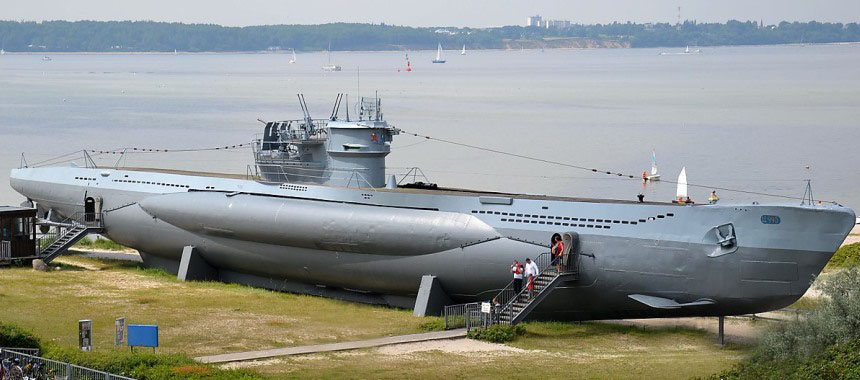 The Type VII U-Boat
The Type VII U-Boat
When Donitz looked at the boats available to him in 1936, he decided that the only boat that would continue to be built after initial orders had been completed would be the Type VII class. However, experiences with and these are shown in the details of the individual types below. In general terms, the class increased in displacement, range, torpedo-carrying capacity and offensive/defensive armament, as well as being increasingly more elaborately equipped with ECM sets of varying function and efficiency. But the basic form of the boats, remained as in the original. The general opinion of the boats was favorable from the officers` and crews` point of view, and they proved their worth in the Battle of the Atlantic, for which they were mainly responsible.
The Type VII U-Boat general characteristics:
- Displacement — 769 long tons (781 t) surfaced
- Builders: 27-32 Deschimag, Bremen 33-36, Germaniawerft, Kiel 1935 — 1936
- Length — 45,5 m
- Beam — 4,7 m
- Draught — 4,3 m
- Test depth — 100 m
- Diving times — 50 seconds
- Crush depth — 200 m
- Engines — two MAN M6V 40/46 diesels totaling 2,310 shp
- Speed — 17,7 knots surfaced 7,6 knots submerged
- Range — 6,200 sea miles
- Complement — 4 officers and 40 ratings
- Armament the Type VII U-Boat:
- Torpedo tubes 533 mm — 5
- Gun fitted forward of the tower C35 L/45 88 mm — 1
- Gun C30 20 mm aft of tower — 1.
- Comments
 en
en ru
ru uk
uk
